Siphon for a shower cabin with a low tray: types, selection rules, assembly and installation
Draining contaminated water is an important point when using a bathtub, sink, bidet and other fixtures.Therefore, a siphon for a shower stall with a low tray plays an important role in the design of plumbing products - in many ways, it depends on the drain fittings whether the user will receive the expected level of convenience and comfort.
Moreover, this is relevant for pallets of any technological complexity and cost.
In this material we will talk about how a siphon for a shower stall works, we will understand their varieties and give the basic rules for choosing a device.
The content of the article:
What is the siphon used for?
Each modern drain is a key element of the entire water drainage system. The proper functioning of a free-standing pallet depends on the reliability, efficiency and correct connection of this part of the structure, shower stall.
Any siphon is designed to solve the following problems:
- drain contaminated water into the sewer pipe without interruption;
- prevent the entry of foul odor into the living space.
To successfully solve the problem specified in the first paragraph, plums are made in various shapes and sizes. The connection angles and drain diameter also differ. All this allows any buyer to find the right solution.
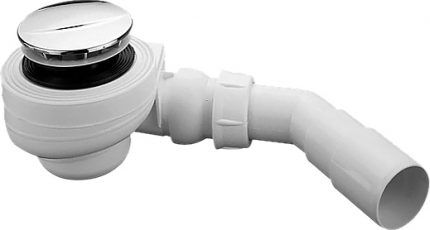
To prevent sewer odors from entering the bathroom, two methods are used, including the use of a water seal and a membrane.
Any water seal is a water plug formed by bending the siphon so that the drain pipe is always blocked by a certain amount of liquid, even when the shower is not used for a long time.
This is a reliable and proven method for decades that allows you to satisfy all customers.
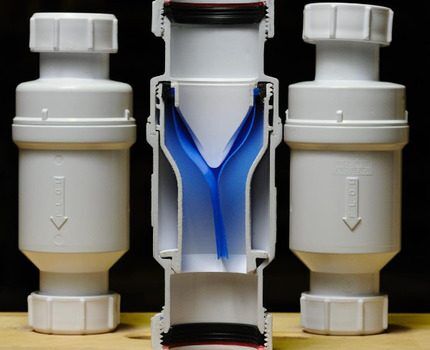
Membrane - is a soft silicone tube that stretches when liquid is removed and returns to its original position in the absence of water. This modern method is efficient and reliable.
Types of drains for low pallets
Although visually the siphon is a simple plastic product, in most cases potential buyers are faced with the problem of choosing it. Since there are a large number of standard sizes and shapes.
Despite all the diversity, they produce products of all certain varieties, including pipe, corrugated, bottle. Separately, it is worth highlighting dry siphons.
In addition, not all of the listed types are the optimal solution specifically for low pallets, since their height is a significant and important limitation. This fact further simplifies the selection procedure for a person who does not know the intricacies of this issue.
The difficulty of adjusting the pipe siphon
Modern pipe drains are compact, so choosing the right option is easy even for the lowest pallets.
In addition to this important advantage, the products are distinguished by a rigid, durable design.And the smooth inner surface eliminates the need for frequent cleaning, which is a significant advantage.
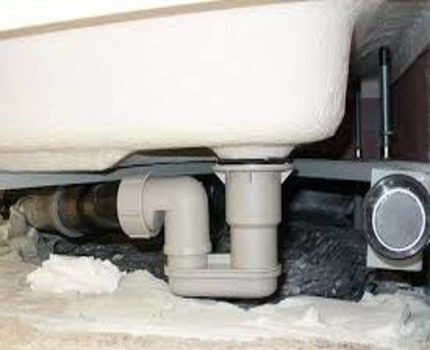
Any model has a water seal that eliminates the appearance of unpleasant odors in the living room. The presence of such an element in the design leads to the fact that the shape of the product is S or U-shaped.
The variety of shapes facilitates the installation of the siphon. But the rigid structure still requires precise fitting and alignment of elements during installation, which is a relative disadvantage.
Corrugation - convenient, cheap, short-lived
The so-called corrugated siphons are named for their material, which is an elastic plastic hose. This also determined the main characteristics, advantages and disadvantages of these products.
The corrugation is flexible, so it is easy, convenient and quick to install. The material used is low in cost and as a result, this type is the most affordable among all other varieties.
But the disadvantages of such siphons are no less impressive - for flexibility, the corrugated hose is made as thin as possible, which negatively affects its durability.
The main problem occurs due to the fact that the product is given an S or U-shape to form a water seal. After which, significant stress arises at the bending points, which the thin-walled material cannot withstand for a long time, and therefore fails.
The quality of workmanship does not provide any guarantee of reliability - to a large extent everything depends on the tension in the bending areas and the loads during use.
Corrugated siphons have another important drawback, which is due to the design of the hose. So, in its internal folds dirt is constantly deposited in large quantities, coming along with the drained water.

As a result, such products quickly become clogged, so they must be cleaned frequently. Moreover, this should not be done with the metal brushes that many are accustomed to, since there is a high probability that the thin-walled hose will be damaged. After which it will definitely have to be changed.
Despite these negative aspects, the affordable cost makes corrugated siphons the most popular type. Still, you should remember that this is just a budget option and, if possible, should be abandoned.
Dry version of the drain device
So-called dry siphons are a relatively new type of drainage equipment. The main feature is that it is equipped with a silicone membrane, the principle of operation of which is described above.
This made it possible to refuse water seal, which brought tangible benefits. And most importantly, it made it possible to significantly reduce the size of the product. Now it has become possible to install it even under the lowest pallets, which is an undeniable advantage in the eyes of users. This innovation simplifies installation and saves space.
It is important that dry siphons are less contaminated than all other types. The reason lies in the presence of fewer bends and parts, which prevents dirt from forming massive plugs.
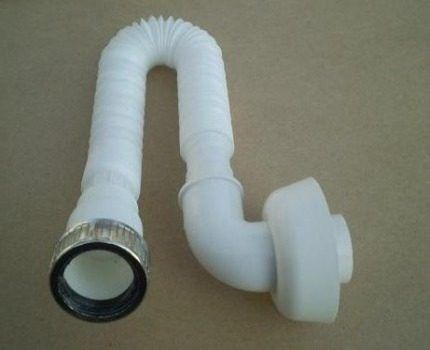
In addition, this type of siphons is reliable and durable. This is also true for the silicone membrane itself, which is insensitive to different temperatures and their differences.
This means that she can easily tolerate being around warm floors, which are the main enemies of water seals, since they simply dry out all the moisture inside the siphons to prevent sewer odors from entering the room. That is, high temperatures and dryness do not affect the performance and durability of such products.
An important advantage of dry siphons is the ability to remain operational even in severe frosts. Therefore, they are an excellent option for inconsistently heated bathhouses and houses, since there is no need to carry out conservation by removing water, as is the case with water seals, and this greatly increases comfort.
But this species also has its own fly in the ointment - their considerable cost. Repairs are also expensive, although breakdowns do not happen often.
Features of bottle models
This type of siphon got its name for its resemblance to the shape of a bottle; the dimensions are also almost similar. As a result, most low shower owners will not be able to install these products due to limited space under their shower stalls. And it is additionally needed to disassemble the siphon before cleaning.
But there are all sorts of situations, therefore, if there is enough space under the pallet, then it is worth remembering that all products belonging to this type are durable, simple in design, and easy to clean from dirt.

To perform the cleaning procedure, simply unscrew the bottom of the bottle itself and then rinse it. This will only take a few minutes, and the procedure is performed without the use of any special tool. It will take a little more time to install the removed element.
Such siphons operate on the principle of a water seal. It is formed by an inlet and an outlet located on top of the structure and a unscrewing lower part.
All bottle drain models are easier to install than tubular ones, and this is also an advantage, and a significant one.
But, as mentioned above, this siphon is an excellent option for a shower with a high tray.
We also recommend reading our other material, where we conducted a detailed review of the different types of shower trays. Read more - read Further.
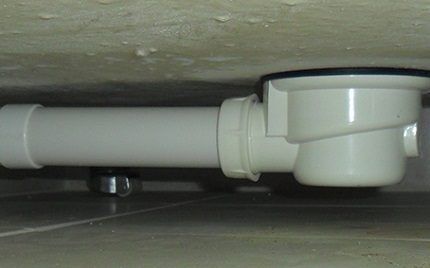
Product management nuances
Often during operation of the pan there is a need to control the water level, that is, it will need to be made larger or smaller.
This can happen when washing a child, doing laundry, warming up the structure, to provide greater comfort, and so on. In such situations, you will have to close the drain hole of the siphon to stop the drainage of liquid.
Cheap way to adjust
To perform the described procedure, the drain fittings are equipped with various devices and mechanisms.
There are 3 main control options:
- using a cork;
- automatic;
- click-clack option.
Each of these methods has its own advantages and disadvantages, which makes using the pallet more comfortable or vice versa. It also has a significant impact on the cost of the siphon.
Such a device as a cork is familiar to everyone, as it has found its place in the designs of bathrooms and showers since archaic times. To use it to block or open the drain hole. a person has to perform a number of not always convenient manipulations.
This option is the most affordable, since the cost of traffic jams is low. In case of loss or failure, the owner of the pallet will also not suffer significant financial losses.

It has only one drawback, but today it is significant - the need to come into contact with water, which is especially unpleasant when it is contaminated.
If the above minus does not impress you, then you can safely buy a siphon equipped with a stopper. Moreover, it will help save money, because it belongs to budget fittings. Other options will significantly increase the cost of purchasing drainage equipment.
Automatic control option
This method makes the drain control procedure more comfortable. An automatic siphon is a common product belonging to one of the above types. Additionally, it is equipped with a lever connected to a damper that closes the drain hole upon command.
For comfort, the control is installed in the area of the mixer. That is, a person does not need to come into contact with contaminated water, bend over, or perform any other inconvenient manipulations.This is the main advantage of any automatic siphon, but its cost becomes noticeably higher.
What is a Click-clack button?
This is the most modern way to control the discharge of contaminated water. Click-clack is a valve installed on the drain hole that changes position when pressed with your foot.
That is, during the first manipulation, the drainage of fluid stops, and during the second operation, it opens.
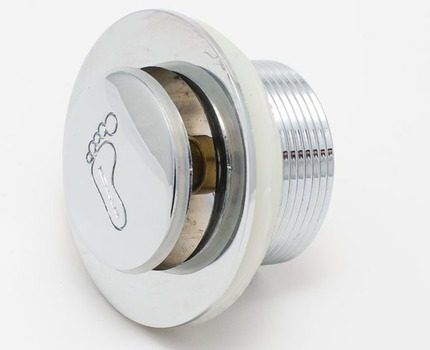
The valve is installed in such a way that it is always convenient to operate, even for people with different physical abilities.
Tangible advantages are the absence of additional work during installation, since this mechanical plug is part of the siphon. Unlike the automatic siphon lever, which must be mounted separately.
In addition, the click-clack valve is reliable and attractive in design. An obvious disadvantage is that the cost of siphons equipped with this device is not the most affordable, which does not contribute to their mass distribution.
At the same time, a potential buyer should pay attention to the feature of a low pan - it is less designed for regulating the water level than a deep one. Therefore, the advantages that the rather expensive automatic siphon and click-clack provide are partially neutralized in this case.
This indicates that the owner of a low pallet should think carefully about whether he needs to overpay for expensive options with reduced efficiency.Or simply limit yourself to using a cheap and familiar cork on a chain, so that a valuable device does not get lost at certain moments.

Device selection rules
Despite the large number of siphons on the market, making the right choice is not so difficult, even for a person far from this topic. You just need to know a few important rules.
When choosing, you must do the following:
- Check technical specifications, including throughput. Since the siphon must be quite productive, that is, it must ensure the drainage of the required amount of contaminated water.
- Study the design features. For example, to clarify whether it is possible to precisely adjust the siphon during installation, to fit into the drain hole of the pan.
- Make sure it is easy to clean. This must be done if you do not want to regularly remove dirt or completely dismantle the siphon, or even along with the pan.
- Check the quality of workmanship, assembly, and absence of signs of damage.
Any siphon is attached to a low tray where there is a special hole. They come in diameters of 52 and 62 mm. The required size must be clarified in advance, which can be done using a pallet passport or regular measurements.
You should not install a 52mm product in a larger hole. Since even the use of gaskets and sealants, including the popular silicone, will not lead to a positive result.
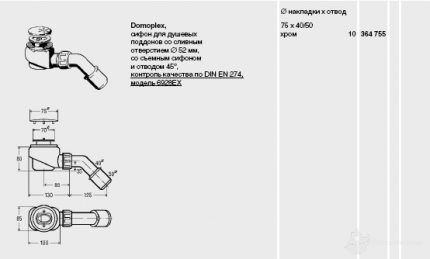
The reason is that during operation the joint will be subject to significant loads and temperature changes, which the seal is not required to withstand. There are fastening parts for this.
All of the above indicates that the drain pipe and the pan hole must fit each other perfectly - only this will ensure longevity of use.
In addition, a drain pipe with a smaller diameter than required may not provide the required performance. As a result, you will have to constantly control the water pressure, which is inconvenient.
The required capacity of the siphon is provided by 52 and 62 mm drain pipes. But you should know that they can only cope with a water level not exceeding 12 cm. If the depth can be greater, then you should use products equipped with a 90 mm drain pipe.
Low pallets do not have an overflow, which can save you from troubles in the form of spilled water on the floor, or even flooding of your neighbors or your home.
Therefore, the siphon must perform its functions uninterruptedly, which can be facilitated by the self-cleaning function, which prevents clogging of the internal volume of the product with subsequent overflow of water.

Self-cleaning occurs due to special shapes and bends in the siphon design, which prevent dirt from accumulating inside. The disadvantage is that additional costs from manufacturers affect the cost of the product, but it is worth spending money on such an option.
If it is not possible to purchase a self-cleaning siphon, then the drain pipe must be protected with a special mesh. It works as a coarse filter, so it helps capture most large dirt particles. This makes it possible to effectively protect the drain fittings from clogging.
But anything can happen, so in any case it should be possible to easily clean the internal channels of the siphon. So, you should consider how the drain fittings will be accessed while using the pallet.
To make the procedure easier, it is better to buy a siphon with a control hole - unscrewing one screw is much easier than dismantling the entire product.
Siphon assembly and installation
If desired, drain fittings of any type can be installed independently. This must be done after installation of the pallet itself on the frame. If you do this, you may accidentally damage structural parts.
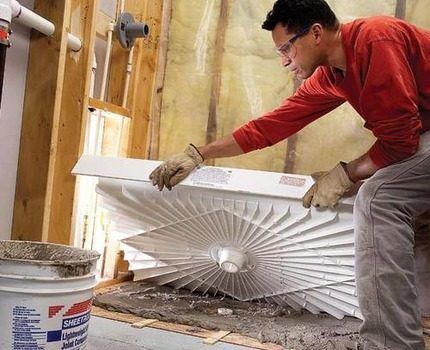
To perform installation, you must follow these recommendations:
- Unpack and disassemble the purchased siphon.
- Apply sealant around the perimeter of the pan drain hole. This is an easy operation as there is a groove there which makes the operation convenient and avoids mistakes.
- The sealant is covered with a gasket included in the fitting kit.
- Next, the siphon, or rather its inlet pipe, is installed in the drain hole of the pan. Since the product is plastic, you should handle its threads carefully when screwing.
- The outlet should be directed towards the sewer pipe.
- Assemble the siphon. For this purpose, the lid is first installed, then its connection is attached and tightened.
The top of the gasket is again treated with sealant; this will not cause any difficulties either, since it has a recess that just needs to be filled. At the end of installation, the drain fittings are connected to the sewer system.
This installation procedure is similar for all modern models of such equipment. When connecting the siphon, you can use various adapters and a corrugated hose, which makes the procedure easier.
Conclusions and useful video on the topic
This video will allow you to study the design of siphons, and at the same time learn how to disassemble them:
The following video describes how to replace drain fittings:
The last video will provide information about what a siphon with a click-clack button is:
Despite the variety of siphons on the market, choosing the right product is relatively simple. All you need is a little knowledge and care when purchasing.
Also, you should not save too much, since any siphon has a service life that is several times shorter than that of the pallet itself, and the durability of inexpensive products may be even lower. Which will result in additional costs and inconvenience.
While studying the material, questions arose regarding the selection or installation siphon for shower cabin? Please ask them in the comments section, and we will try to answer as quickly as possible.




Hello. I have a low shower tray with a simple drain. The corrugation goes into a hole in the floor. Do I need to install a water seal?